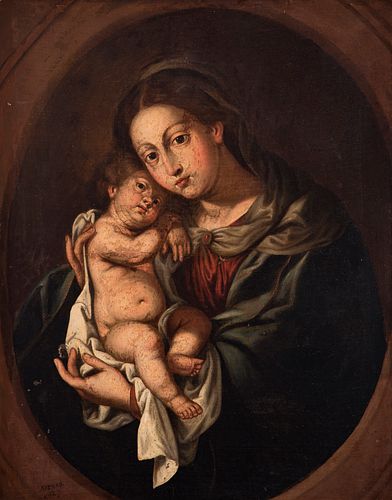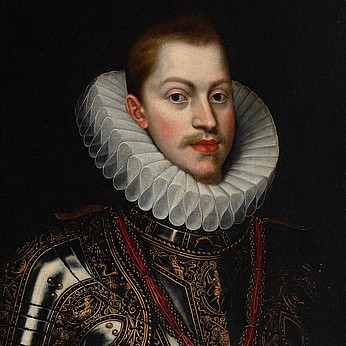PEDRO ANASTASIO BOCANEGRA (Granada, 1638 - 1689). "Virgin with Child". Oil on canvas.
Lot 67
About Seller
Setdart Auction House
Carrer Aragó 346
Barcelona
Spain
Setdart Subastas was born in 2004 and is currently the first online art auction in Spain with solidity, prestige and reliability guaranteed by our more than 60,000 users. Setdart has a young, dynamic and enterprising team ready to successfully manage the purchase and sale of art works through custom...Read more
Estimate:
EUR€10,000 - EUR€12,000
$10,752.69 - $12,903.23
Absentee vs Live bid
Two ways to bid:
- Leave a max absentee bid and the platform will bid on your behalf up to your maximum bid during the live auction.
- Bid live during the auction and your bids will be submitted real-time to the auctioneer.
Bid Increments
| Price | Bid Increment |
|---|---|
| EUR€0 | EUR€10 |
| EUR€200 | EUR€25 |
| EUR€500 | EUR€50 |
| EUR€1,000 | EUR€100 |
| EUR€3,000 | EUR€200 |
| EUR€5,000 | EUR€500 |
| EUR€10,000 | EUR€1,000 |
| EUR€20,000 | EUR€2,000 |
| EUR€50,000 | EUR€5,000 |
About Auction
By Setdart Auction House
Nov 24, 2021
Set Reminder
2021-11-24 09:00:00
2021-11-24 09:00:00
America/New_York
Bidsquare
Bidsquare : Old Masters, Day 1
https://www.bidsquare.com/auctions/setdart-auction-house/old-masters-day-1-7873
Setdart Auction House sofia@setdart.com
Setdart Auction House sofia@setdart.com
- Lot Description
PEDRO ANASTASIO BOCANEGRA (Granada, 1638 - 1689). "Virgin with Child". Oil on canvas. Measurements: 82 x 65 cm; 106 x 90 cm (frame). In this work the Virgin with the Child is presented following the usual forms within the devotional painting of the Spanish Baroque: Mary appears half-body with the Child in her arms, in the foreground and on a neutral, dark background, on which the figures stand out voluminous and directly illuminated. The painting corresponds to the theme, composition and technique of Pedro Atanasio, very influenced by Alonso Cano and Van Dyck. It emphasizes the love between mother and son through a naturalistic and tender representation, with the two characters joining heads. Pedro Atanasio de Bocanegra, a disciple of Alonso Cano, Pedro Moya and Juan de Sevilla, became the most active artist in his native city in the 1660s. His first known work was the decorations for the Corpus Christi festivities in his hometown in 1661. During the following years we find commissions such as the series of canvases that he executed between 1665 and 1666 for the cloister of the convent of Nuestra Señora de Gracia, now lost; or the numerous paintings, among them the "Conversion of St. Paul", which he painted between 1668 and 1672 for the altar of the school of the Society of Jesus, now the church of Saints Justo and Pastor (in situ). At the same time he was commissioned to decorate the Carthusian monastery of Granada with large scenes on the life of the Virgin, a set that includes two works currently preserved in the Prado Museum: "Apparition of the Virgin to St. Bernard" and "The Virgin and St. Peter giving the rule to some Carthusian friars". He was also appointed painter of the cathedral. After this period he went to Seville in 1686, and from there he left for the court of Madrid, where he was protected by Don Pedro de Toledo, Marquis of Mancera. Thanks to the influence of his protector, Bocanegra achieved the title of painter of the king "ad honorem" for his painting "Allegory of Justice", inspired by a Venetian print of the mid-sixteenth century, and currently preserved in the Royal Academy of San Fernando. Other conserved works of his are "The Adoration of the Eucharist" (convent of the Góngoras, Madrid), several portraits of members of the Trinitarian order (Palace of Charles V, Granada), as well as those conserved in the Prado: several paintings representing the Virgin and Child and different saints, and "The Triumph of David". After his stay in Madrid, Pedro Bocanegra returned to Granada, where he met the painter and architect Teodoro de Ardemans, who portrayed him in a canvas kept in the archbishop's palace of Granada. Bocanegra developed a style close to that of his master Cano, being admired for the great charm of his religious images, represented with great delicacy. His weakness in drawing was compensated by a pleasant coloring, very well worked, which shows his interest in contemporary Flemish art, especially that of Anton van Dyck. In addition to the aforementioned art galleries and religious centers, we can currently find works by this master in the Museum of Zaragoza, the Museum of Goya in Castres, the Diocesan Museum of Sacred Art in Vitoria and the Museum of Fine Arts in Granada, as well as in various private collections.
- Shipping Info
-
In-house shipping available. Please inquire at admin@setdart.com.
-
- Buyer's Premium



 EUR
EUR CAD
CAD AUD
AUD GBP
GBP MXN
MXN HKD
HKD CNY
CNY MYR
MYR SEK
SEK SGD
SGD CHF
CHF THB
THB

















